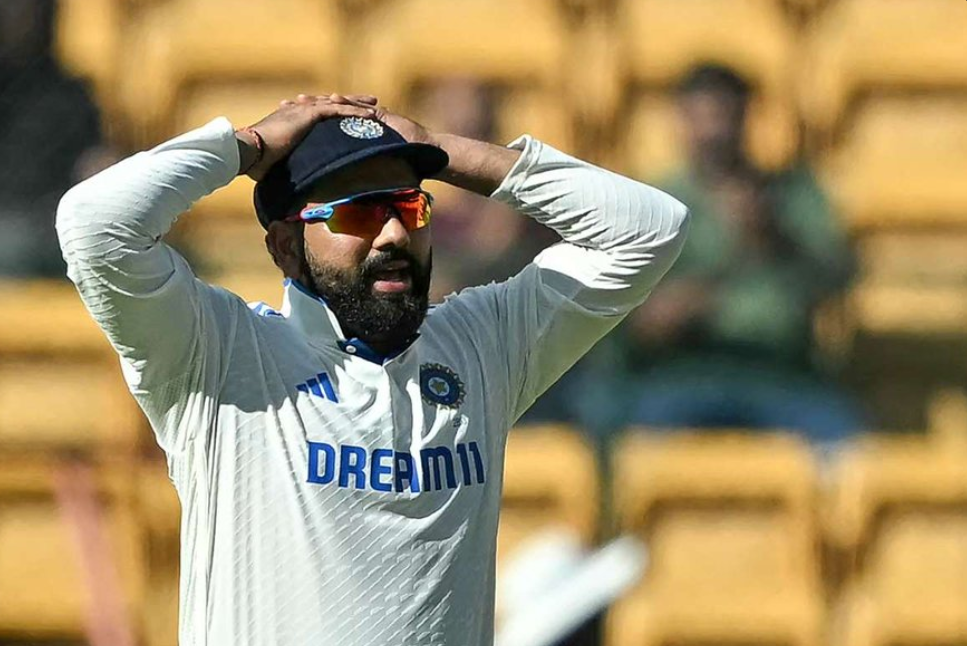Rohit Sharma said “I am hurting to see this score of 46 as Captain as it was my call to bat first”
Rohit Sharma, the captain of the Indian cricket team, was deeply disappointed. His team’s batting on the second day of the first Test against New Zealand in Bengaluru was poor. India scored a meager 46 runs, their third-lowest score at home. Sharma said, “I am hurting to see this score of 46 as captain as it was my call to bat first.”
Key Takeaways
- India faced a shocking batting collapse, being bowled out for just 46 runs in the first innings of the first Test against New Zealand.
- Captain Rohit Sharma took responsibility for the decision to bat first, acknowledging that it was a mistake that led to the team’s dismal performance.
- This was India’s third-lowest Test score at home, following their 36 all-out against Australia in 2020 and 42 all-out against England in 1974.
- The team’s struggles in the face of a strong New Zealand bowling attack have raised concerns about their ability to perform in the longer format of the game.
- Sharma’s candid admission of the team’s shortcomings and his willingness to take accountability as the captain have been praised by fans and experts alike.
India’s Batting Collapse in the First Test Against New Zealand
Scores and Highlights of the Dismal Batting Performance
India’s batting lineup fell apart against New Zealand’s bowling on the second day in Bengaluru. They were bowled out for just 46 runs in 31.2 overs. This is their lowest score at home, beating their previous record of 62 against New Zealand in 2021.
Pacers Matt Henry and William O’Rourke led the india batting collapse. They used the overcast weather to their advantage. The Indian batsmen, led by Rohit Sharma, struggled with the swing and seam. Five of them didn’t even score a run.
| Player | Runs Scored |
|---|---|
| Mayank Agarwal | 17 |
| Cheteshwar Pujara | 0 |
| Rohit Sharma | 15 |
| Virat Kohli | 0 |
| Shreyas Iyer | 4 |
| Wriddhiman Saha | 1 |
| Ravichandran Ashwin | 0 |
| Jayant Yadav | 5 |
| Axar Patel | 0 |
| Mohammed Shami | 0 |
| Umesh Yadav | 4 |
This poor batting by the india team against the new zealand bowling has raised big concerns. It shows they struggle in test cricket, especially at home. The team and fans are hoping for a strong comeback in the rest of the series.
Rohit Sharma said “I am hurting to see this score of 46 as Captain as it was my call to bat first”
In the post-day press conference, India’s rohit sharma, the team’s captain, showed his sadness. The team scored only 46 in the first innings of the opening test cricket match against New Zealand.
“I am hurting to see this score of 46 as captain as it was my toss decision to bat first,” Rohit acknowledged, taking responsibility for the team’s dismal batting performance.
But the captain also said, “one or two bad calls in a year is quite alright.” This shows the team is ready to learn from this setback. They aim to come back strong in the rest of the series.
Rohit’s words underline the key role of captain responsibility in test cricket. Decisions made at key moments can greatly affect the team’s performance.
The captain’s readiness to accept the decision and show his disappointment shows the team’s dedication. They are committed to self-reflection and improvement. This will be key as they face the challenge of bouncing back from this early setback.
India’s Lowest Test Scores at Home
India’s batting in the first Test against New Zealand was a disaster. They scored just 46 in the first innings, their lowest score at home. This broke their previous record of 62 against New Zealand in 2021.
India has had other low scores at home too. They were bowled out for 36 against Australia in 2020 and 42 against England in 1974. These collapses show the team’s struggles to adapt and stay strong in test cricket.
| Lowest Test Scores for India at Home | Opponent | Year | Score |
|---|---|---|---|
| 1. 46 all-out | New Zealand | 2023 | 46 |
| 2. 62 all-out | New Zealand | 2021 | 62 |
| 3. 36 all-out | Australia | 2020 | 36 |
| 4. 42 all-out | England | 1974 | 42 |
These low scores show India’s struggles in home tests, especially against strong bowlers. The team must work on building resilience and adapting to test cricket.
New Zealand Take the Lead on Day Two
The second day of the Test match between India and New Zealand was a big win for the visitors. Their bowlers did great, helping New Zealand take a strong lead. This put the hosts in a tough spot.
Devon Conway’s Heroics and New Zealand’s Commanding Position
Devon Conway played a fantastic innings, scoring 91 runs. He led the Kiwi team to a total of 180/3 at stumps. This gave New Zealand a 134-run lead over India’s first-innings total of 46.
Rachin Ravindra and Daryl Mitchell were not out, making New Zealand’s lead even stronger. The New Zealand bowlers, led by Matt Henry and William O’Rourke, had earlier taken down the Indian batsmen. This set the stage for their strong batting on day two highlights of the test cricket match.
New Zealand now has a big lead and the momentum. They are in a great position to control the test cricket series. The india bowling team will need to find a way to stop the Kiwi batsmen if they want to turn things around.
Analyzing Rohit Sharma’s Decision to Bat First
Rohit Sharma’s choice to bat first after winning the toss in the first Test against New Zealand has sparked a lot of debate. He admitted that the decision might have been wrong, saying, “I am hurting to see this score of 46 as Captain as it was my call to bat first.”
The weather at the Bengaluru stadium seemed to favor the bowlers. The New Zealand pacers took advantage of this, making Rohit’s decision to bat first seem questionable. This has led to questions about the team’s tactics and how well they adapt to different situations during a match.
Rohit stood by his choice, saying that “one or two bad calls in a year is quite alright.” However, the Indian batters’ performance has been disappointing. Critics and fans alike have pointed out that the rohit sharma decision to bat first was not the best. They believe the toss decision and test cricket strategy should have better matched the weather conditions.
The team’s struggle to adjust their batting first strategy in favorable bowling conditions has raised concerns. As the series goes on, Rohit and his team will need to rethink their approach. They must make changes to perform better in the upcoming matches.
“I am hurting to see this score of 46 as Captain as it was my call to bat first.”
The Importance of Building Resilience in Test Cricket
The Indian team’s shocking batting collapse in the first Test against New Zealand shows the need for more resilience in test cricket. This format requires overcoming setbacks, adapting to changing conditions, and bouncing back strongly. The team’s struggles with tough conditions and New Zealand’s tight bowling have revealed weaknesses that need fixing.
It’s vital for the Indian players to learn from this failure, understand their mistakes, and come up with new strategies for the future. Building resilience in test cricket goes beyond just technical skills. It also involves mental strength, adaptability, and a readiness to learn from failures.
Learning from Setbacks and Adapting to Conditions
The India batting collapse in the first Test, where they scored just 46 runs, is a harsh reminder of the team’s need for a stronger mindset in test cricket. Test cricket resilience is not just about technical skill; it’s also about mental toughness to adapt to conditions and learn from setbacks.
The Indian batsmen must carefully review their approach and make changes to their game plans to do better in the rest of the series. Adapting to conditions and learning from setbacks will be crucial for their success against a tough New Zealand team.
“I am hurting to see this score of 46 as Captain as it was my call to bat first,” said Rohit Sharma, showing the team’s disappointment and the need to bounce back strongly.
The India batting collapse highlights the importance of building resilience in the team’s mindset. By learning from setbacks and adapting to conditions, the Indian players can gain the mental toughness needed to excel in the demanding test format.
The journey ahead will be tough, but the Indian team must face the challenge head-on. They should use this experience to grow stronger and become a more resilient unit in test cricket.
Rebuilding and Bouncing Back in the Test Series
The first Test against New Zealand was tough for India. But it’s a chance for the team to come together, rethink their plans, and show strength in the rest of the series. Players and coaches will look into why things went wrong. They aim to build confidence and a stronger test cricket mindset.
Learning from mistakes and adjusting to tough conditions are key for India’s success in the india test series. The team has bounced back before. They’ll use that experience to face this challenge.
To rebuild, the team will work on many areas. They’ll tweak their skills, prepare mentally, and focus on teamwork. The older players will lead, and the young ones will bring new ideas.
As the series goes on, India must stay focused and disciplined. By bouncing back, they can win the series and set up for future test cricket success.
“I am hurting to see this score of 46 as Captain as it was my call to bat first,” said Rohit Sharma after the first Test.
India’s strength and ability to adapt will be tested in the next games. But with the right attitude and purpose, they can come out stronger and more united.
Conclusion
The first Test against New Zealand was a tough loss for India and its captain, Rohit Sharma. Sharma said choosing to bat first was a mistake. This shows the team is ready to own up to their mistakes.
This failure is a chance for the team to improve and get stronger in Test cricket. They need to work on handling tough conditions and learning from their mistakes. Sharma stressed that winning as a team is more important than personal records.
This loss is a wake-up call for India. With the right attitude, they can come back stronger. The India batting collapse is a chance to show they can learn and adapt. This is key for success in Test cricket.
FAQ
What did Rohit Sharma say about the team’s batting performance in the first Test against New Zealand?
Rohit Sharma said batting first might have been a bad choice. He mentioned, “I am hurting to see this score of 46 as captain as it was my call to bat first.”
What was India’s lowest-ever Test total on home soil?
India scored 46 all-out against New Zealand, their lowest total at home. This beats their previous record of 62 against New Zealand in 2021.
How did New Zealand’s bowlers perform in the first Test?
Matt Henry and William O’Rourke were key. They used the cloudy weather to their advantage, causing India’s batting to collapse.
What were some of India’s other lowest Test totals at home?
Before this, India’s lowest totals at home were 36 against Australia in 2020 and 42 against England in 1974.
How did New Zealand perform with the bat on the second day?
Devon Conway led with 91 runs. This helped New Zealand reach 180/3 at stumps, leading by 134 runs.
How did experts and fans react to Rohit Sharma’s decision to bat first?
Experts and fans questioned Rohit Sharma’s choice to bat first. He later said it might have been a mistake.
What does this setback present for the Indian team?
The poor batting in the first Test is a chance for India to come back stronger. They can reassess and improve their strategies for the rest of the series.











